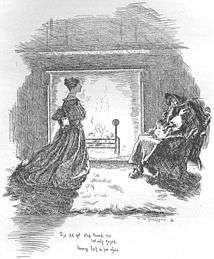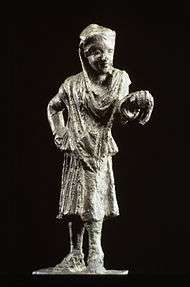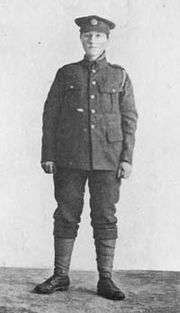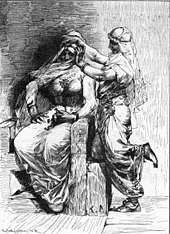History of cross-dressing
This article details the history of cross-dressing, the act of wearing the clothes of the sex or gender one does not identify with.
| Cross-dressing |
|---|
|
|
Key elements |
|
Modern drag culture |
|
Sexual aspects
|
|
Other aspects |
|
Passing as male |
|
Passing as female
|
|
Books
|
Background
Patriarchy is a social system in which men have all of the power towards women and their families in regards to the tradition, law, division of labor, and education women can take part in.[1] Women used cross-dressing to pass as men in order to live adventurous lives outside of the home, which were unlikely to occur while living as women.[2] Women who engaged in cross-dressing in earlier centuries were lower-class women who would gain access to economic independence as well as freedom to travel risking little of what they had.[3] Cross-dressing that consisted of women dressing as men had more positive attitudes than vice versa. Altenburger states that female-to-male cross-dressing depicted a movement forward in terms of social status, power, and freedom.[2]
Men who cross-dressed were looked down upon because they automatically lost status when dressed as a woman.[4] It was also said that men would cross-dress to gain access around women for their own sexual desire.[4]
In mythology
Greek
- In punishment for his murder of Iphitus, Heracles/Hercules was given to Omphale as a slave. Many variants of this story say that she not only compelled him to do women's work, but compelled him to dress as a woman while her slave.
- In Achilles on Skyros, Achilles was dressed in women's clothing by his mother Thetis at the court of Lycomedes, to hide him from Odysseus who wanted him to join the Trojan War.
- Athena often goes to the aid of people in the guise of men in The Odyssey.
- Tiresias was turned into a woman after angering the goddess Hera by killing a female snake that was coupling.
- In the cult of Aphroditus, worshipers cross-dressed, men wore women's clothing and women dressed in men's clothing with false beards.
Norse
- Thor dressed as Freyja to get Mjölnir back in Þrymskviða.
- Odin dressed as a female healer as part of his efforts to seduce Rindr.
- Hagbard in the legend of Hagbard and Signy (the Romeo and Juliet of the Vikings).
- Frotho I dressed as a shieldmaiden in one of his eastern campaigns.
- Hervor from the Hervarar saga. When Hervor learnt that her father had been the infamous Swedish berserker Angantyr, she dressed as a man, called herself Hjörvard and lived for a long time as a Viking.
Hindu
- The Mahabharata: In the Agnyatbaas ("exile") period of one year imposed upon the Pandavas, in which they had to keep their identities secret to avoid detection, Arjuna cross-dressed as Brihannala and became a dance teacher.
- The goddess Bahuchara Mata: In one legend, Bapiya was cursed by her and he became impotent. The curse was lifted only when he worshiped her by dressing and acting like a woman.
- Devotees of the god Krishna: Some male devotees of the god Krishna, specifically a sect called the sakhi bekhi, dress in female attire as an act of devotion.[5] Krishna and his consort Radha had cross-dressed in each other's clothing. Krishna is also said to have dressed as a gopi and a kinnari goddess.[6]
In folklore
Ballads have many cross-dressing heroines. While some (The Famous Flower of Serving-Men) merely need to move about freely, many do it specifically in pursuit of a lover (Rose Red and the White Lily or Child Waters) and consequently pregnancy often complicates the disguise. In the Chinese poem the Ballad of Mulan, Hua Mulan disguised herself as a man to take her elderly father's place in the army.
Occasionally, men in ballads also disguise themselves as women, but not only is it rarer, the men dress so for less time, because they are merely trying to elude an enemy by the disguise, as in Brown Robin, The Duke of Athole's Nurse, or Robin Hood and the Bishop. According to Gude Wallace, William Wallace disguised himself as a woman to escape capture, which may have been based on historical information.
Fairy tales seldom feature cross-dressing, but an occasional heroine needs to move freely as a man, as in the German The Twelve Huntsmen, the Scottish The Tale of the Hoodie, or the Russian The Lute Player. Madame d'Aulnoy included such a woman in her literary fairy tale, Belle-Belle ou Le Chevalier Fortuné.
In festivals
In the cities Techiman and Wenchi (both Ghana) men dress as women – and vice versa – during the annual Apoo festival (April/May).
In literature

Cross-dressing as a literary motif is well attested in older literature but is becoming increasingly popular in modern literature as well.[7] It is often associated with character nonconformity and sexuality rather than gender identity.[8]
On stage and on the screen

Many societies prohibited women from performing on stage, so boys and men took the female roles. In the ancient Greek theatre men played females, as they did in English Renaissance theatre and continue to do in Japanese kabuki theatre (see onnagata).
Cross-dressing in motion pictures began in the early days of the silent films. Charlie Chaplin and Stan Laurel brought the tradition of female impersonation in the English music halls when they came to America with Fred Karno's comedy troupe in 1910. Both Chaplin and Laurel occasionally dressed as women in their films. Even the beefy American actor Wallace Beery appeared in a series of silent films as a Swedish woman. The Three Stooges, especially Curly (Jerry Howard), sometimes appeared in drag in their short films. The tradition has continued for many years, usually played for laughs. Only in recent decades have there been dramatic films in which cross-dressing was included, possibly because of strict censorship of American films until the mid-1960s.
Cross-gender acting, on the other hand, refers to actors or actresses portraying a character of the opposite gender.
In music
By era
Medieval Europe
It was once considered taboo in Western society for women to wear clothing traditionally associated with men, except when done in certain circumstances such as cases of necessity (as per St. Thomas Aquinas's guidelines in Summa Theologiae II), which states: "Nevertheless this may be done sometimes without sin on account of some necessity, either in order to hide oneself from enemies, or through lack of other clothes, or for some similar motive."[9] Cross-dressing is cited as an abomination in the Bible in the book of Deuteronomy (22:5), which states: "A woman must not wear men’s clothing, nor a man wear women’s clothing, for the Lord your God detests anyone who does this",[10] but as Aquinas noted above this principle was interpreted to be based on context. Other people in the Middle Ages occasionally disputed its applicability; for instance, the 15th-century French poet Martin le Franc, wrote:
Don't you see that it was forbidden
That anyone should eat of an animal
Unless it had a cleft foot
And chewed its cud?
To eat of a hare no one dared
Neither of sow nor of piglet,
Yet should you now be offered any,
You would take many a morsel.[11]
By country
Historical figures
Famous historical examples of cross-dressing people include:

Many people have engaged in cross-dressing during wartime under various circumstances and for various motives. This has been especially true of women, whether while serving as a soldier in otherwise all-male armies, while protecting themselves or disguising their identity in dangerous circumstances, or for other purposes. Conversely, men would dress as women to avoid being drafted, the mythological precedent for this being Achilles hiding at the court of Lycomedes dressed as a girl to avoid participation in the Trojan War.
- Several tales of the Desert Fathers speak of monks who were disguised women, and being discovered only when their bodies were prepared for burial. One such woman, Marina the Monk, died 508, accompanied her father to a monastery and adopted a monk's habit as a disguise. When falsely accused of getting a woman pregnant, she patiently bore the accusation rather than revealing her identity to clear her name, an action praised in medieval books of saints' lives as an example of humble forbearance.
- In monarchies where the throne was inherited by male offspring, male descendants of deposed rulers were sometimes dressed as female so that they would be allowed to live. One example was the son of Korean Princess Gyeonghye, herself the daughter of a former king, who was dressed in female clothes in his early years to fool his great uncle into thinking he was not a male descendant of Munjong.[12]
- The legend of Pope Joan alleges that she was a promiscuous female pope who dressed like a man and reigned from 855 to 858. Modern historians regard her as a mythical figure who originated from 13th-century anti-papal satire.[13]
Spain and Latin America
Catalina de Erauso (1592–1650), known as la monja alférez "the Nun Lieutenant", was a Spanish woman who, after being forced to enter a convent, escaped from it disguised as a man, fled to America and enrolled herself in the Spanish army under the false name of Alonso Díaz Ramírez de Guzmán.[14] She served under several captains, including her own brother, and was never discovered. She was said to behave as an extremely bold soldier, although she had a successful career, reaching the rank of alférez (lieutenant) and becoming quite well known in the Americas. After a fight in which she killed a man, she was severely injured, and fearing her end, she confessed her true sex to a bishop. She nonetheless survived, and there was a huge scandal afterwards, specially since as a man she had become quite famous in the Americas, and because nobody had ever suspected anything about her true sex. Nevertheless, thanks to the scandal and her fame as a brave soldier, she became a celebrity. She went back to Spain, and was even granted a special dispensation by the pope to wear men's clothes. She started using the male name of Antonio de Erauso, and went back to the America, where she served in the army till her death in 1650.
Scandinavia
Ulrika Eleonora Stålhammar was a Swedish woman who served as a soldier during the Great Northern War and married a woman.
United States
Edward Hyde, 3rd Earl of Clarendon, colonial governor of New York and New Jersey in the early 18th century is reported to have enjoyed going out wearing his wife's clothing, but this is disputed.[15] Hyde was an unpopular figure, and rumors of his cross-dressing may have begun as an urban legend.
Because female enlistment was barred, many women fought for both the Union and the Confederacy during the American Civil War while dressed as men.
Other contemporary cross-dressing artists include J. S. G. Boggs.
France
As the Hundred Years' War developed in the late Middle Ages,[16] cross dressing was a way for French women to join the cause against England.[17] Joan of Arc was a 15th-century French peasant girl who joined French armies against English forces fighting in France during the latter part of the Hundred Years' War. She is a French national heroine and a Catholic saint. After being captured by the English, she was burned at the stake upon being convicted by a pro-English religious court, with the act of dressing in male (soldiers') clothing being cited as one of the principal reasons for her execution. A number of eyewitnesses, however, later explained that she had said she wore soldiers' clothing in prison (consisting of hosen and long hip-boots attached to the doublet with twenty fasteners) because this made it more difficult for her guards to pull her clothing off during rape attempts. She was, however, burned alive in a long white gown.[18]
In the seventeenth century, France underwent a financially driven social conflict, the Fronde.[19] At this period, women disguised themselves as men and enlisted in the army, sometimes with their male family members.[20] Cross dressing also became a more common strategy for women to conceal their gender as they traveled, granting a safer and more efficient route.[20] The practice of cross dressing was present more in literary works than in real life situations, despite its effective concealing properties.[20]
Charles-Geneviève-Louis-Auguste-André-Timothée Éon de Beaumont (1728–1810), usually known as the Chevalier d'Eon, was a French diplomat and soldier who lived the first half of his life as a man and the second half as a woman. In 1771 he stated that physically he was not a man, but a woman, having been brought up as a man only. From then on she lived as a woman. On her death it was discovered that her body was anatomically male.
George Sand is the pseudonym of Amandine-Aurore-Lucile Dupin, an early 19th-century novelist who preferred to wear men's clothing exclusively. In her autobiography, she explains in length the various aspects of how she experienced cross-dressing.
Rrose Sélavy, the feminine alter-ego of artist Marcel Duchamp, remains one of the most complex and pervasive pieces in the enigmatic puzzle of the artist's oeuvre. She first emerged in portraits made by the photographer Man Ray in New York in the early 1920s, when Duchamp and Man Ray were collaborating on a number of conceptual photographic works. Rrose Sélavy lived on as the person to whom Duchamp attributed specific works of art, Readymades, puns, and writings throughout his career. By creating for himself this female persona whose attributes are beauty and eroticism, he deliberately and characteristically complicated the understanding of his ideas and motives.
England, Scotland, and Ireland
In medieval England, cross dressing was normal practice in the theatre, used by men and young boys dressing and playing both roles of male and female.[21] During early modern London, religious authorities were against cross-dressing in theater due to it disregarding social conduct and causing gender confusion.[22]
Later, during the eighteenth century in London, crossdressing became a part of the club culture. Crossdressing took a part in men's only clubs where men would meet at these clubs dressed as women and drink.[23] One of the most well known clubs for men to do this was known as the Molly Club or Molly House.[23]
Anne Bonny and Mary Read were 18th-century pirates. Bonny in particular gained significant notoriety, but both were eventually captured. Unlike the rest of the male crew, Bonny and Read were not immediately executed because Read was pregnant and Bonny stated that she was as well. Charles Edward Stuart dressed as Flora MacDonald's maid servant, Betty Burke, to escape the Battle of Culloden for the island of Skye in 1746. Mary Hamilton dressed as a man to learn medicine and later married a woman in 1746. It was also alleged that she had married and abandoned many others, for either financial gain or for sexual gratification. She was convicted of fraud for misrepresenting herself as a man to her bride. Ann Mills fought as a dragoon in 1740. Hannah Snell served as a man in the Royal Marines 1747–1750, being wounded 11 times, and was granted a military pension.
Dorothy Lawrence was a war reporter who disguised herself as a man so she could become a soldier in World War I.
Writer and doctor Vernon Coleman cross-dresses and has written several articles about men who cross-dress, stressing they are often heterosexual and usually do not want to change sex. Artist and Turner Prize winner, Grayson Perry often appears as his alter-ego, Clare. Writer, presenter and actor Richard O'Brien sometimes cross-dresses and ran a "Transfandango" ball aimed at transgender people of all kinds in aid of charity for several years in the early 2000s (decade). Eddie Izzard, stand-up comedian and actor, states that he has cross-dressed his entire life. He often performs his act in feminine clothing, and has discussed his cross dressing as part of his act. He calls himself an "executive transvestite".
Japan
Japan has a centuries-old tradition of male kabuki theatre actors cross-dressing onstage.[24] Transgender men (and more rarely, women) were also "conspicuous" in Tokyo's gei (gay) bar and club subculture in the pre- and post-World War II period. By the 1950s, publications concerning MTF cross-dressing were in circulation, advertising themselves as aimed at the "study" of the phenomenon. Fully-fledged "commercial" magazines aimed at cross-dressing 'hobbyists' began publishing after the launch of the first such magazine, Queen, in 1980. It was affiliated with the Elizabeth Club, which opened branch clubs in several Tokyo suburbs and other cities.[25] Yasumasa Morimura is a contemporary artist who cross-dresses.
Thailand
Through the pre-modern age, cross-dressing and transgender appearance in Thailand was apparent in many contexts including same-sex theater performance.[26] The term Kathoey came to describe anyone from cross-dressers to transgender men (and women) as the practice became more prevalent in everyday life.[26] Lack of colonization by Western civilizations in Thailand have led to different ways of thinking about gender and self-identity. In turn, Thailand has fostered one of the most open and tolerant traditions towards Kathoeys and cross-dressers in the world.[27] In contrast to many Western civilizations, where homosexuality and cross-dressing have been historically criminal offenses, Thai legal codes have not explicitly criminalized these behaviors.[28] It was not until the 20th century that a public majority, whether on stage or in public, came to assume cross-dressing a sign of transgenderism and homosexuality.[26]
China
Since the Yuan dynasty, cross-dressing has had a unique significance in Chinese opera. Period scholars cite it as the time in Chinese theatre as the "golden age." [29] The rise of dan, though characterized as female characters, was a prominent feature of the Peking Opera and many males took the roles of females. There were schools dedicated to the specific dan training as well.[30] Female crossdressers in the Chinese opera were also valued immensely and prospered far better than male crossdressers did.[29]
Hua Mulan, the central figure of the Ballad of Mulan (and of the Disney film Mulan), may be a historical or fictional figure. She is said to have lived in China during the Northern Wei, and to have posed as a man to fulfill the household draft quota, thus saving her ill and aged father from serving.
Shi Pei Pu was a male Peking Opera singer. Spying on behalf of the Chinese Government during the Cultural Revolution, he cross-dressed to gain information from Bernard Boursicot, a French diplomat. Their relationship lasted 20 years, during which they married. David Henry Hwang's 1988 play M. Butterfly is loosely based on their story.
See also
- Cross dressing ball
- History of drag
- Transgender history
References
- Bennett, Judith M. (2010-01-01). History Matters : Patriarchy and the Challenge of Feminism. Philadelphia: University of Pennsylvania Press, Inc. ISBN 9780812200553.
- Altenburger, Roland (2005-01-01). "Is It Clothes that Make the Man? Cross-Dressing, Gender, and Sex in Pre-Twentieth-Century Zhu Yingtai Lore". Asian Folklore Studies. 64 (2): 165–205. JSTOR 30030419.
- Devor, Holly (1993-01-01). Bullough, Vern L.; Bullough, Bonnie (eds.). "Cross Dressing Then and Now". The Journal of Sex Research. 30 (3): 289–291. doi:10.1080/00224499309551712. JSTOR 3812730.
- Bullough, Vern L. (1974-01-01). "Transvestites in the Middle Ages". American Journal of Sociology. 79 (6): 1381–1394. CiteSeerX 10.1.1.695.1967. doi:10.1086/225706. JSTOR 2777140.
- Cross Dressing & Cross-dresser Krishna - www.speakingtree.in
- Radha and Krishna Dressed in Each Other's Clothes - www.harekrsna.de
- "from Vested Interests: Cross-dressing & Cultural Anxiety (1991)", Marjorie Garber, 1991. Retrieved 21 September 2011.
- Craft-Fairchild, Catherine (1998-01-01). "Cross-Dressing and the Novel: Women Warriors and Domestic Femininity". Eighteenth-Century Fiction. 10 (2): 171–202. doi:10.1353/ecf.1998.0007. ISSN 1911-0243.
- Aquinas, Thomas. "Summa Theologiae Part II". Newadvent.org. Retrieved 28 August 2012.
- "Deuteronomy 22:5 (NIV)". Retrieved 26 September 2017.
- Merkle, Gertrude H. "Fresh Verdicts on Joan of Arc", Martin Le Franc's Commentary on Jean Gerson's Treatise on Joan of Arc, p. 182
-
- Jang 장, Hee-Hyung 희홍. "端宗과 定順王后 兩位 제사의 장기지속 - 海州 鄭氏 寧陽尉派 家系 傳承을 중심으로" [The continuing tradition of memorial services for King Danjong and Queen Jungsun: case study on transmission through the Youngyang-wi branch of the Hyeju Jung family]. The Journal of Korean Historical-Folklife (in Korean). 41: 165–193.
- Boureau, Alain (2001). The Myth of Pope Joan. Translated by Lydia G. Cochrane. University of Chicago Press. p. 8. ISBN 0226067459.
- According to her supposed autobiography, Mi vida, ed.Auñamendi, 1994
- The Straight Dope: Did New York once have a transvestite governor?
- Sumption 1991, p. 180
- Feinberg, Leslie. Transgender Warriors: Making History from Joan of Arc to Dennis Rodman. Boston: Beacon Press, 1996. 32-35. Joan of Arc was of adolescent age when she decided to present herself alongside her peasant army to Prince Charles, heir to the French throne, who confirmed her leadership role. This can be attributed to her defense of her dressing in men’s clothing as a direct order from God which correlates to the religious attribute of the feudal life of the time. A couple years after joining the fight, Joan of Arc was captured in 1492 by allies of England. Despite her importance in the cause, the now King Charles did not ransom her.
- Joan of Arc, Male Clothing Issue
- Treasure, Geoffrey. "THE FRONDE Part II: The Battle for France." History Today 28, no. 7 (July 1978): 436. Academic Search Complete, EBSCOhost (accessed December 1, 2016).
- Harris, Joseph. Hidden Agendas: Cross-dressing in 17th-century France. Tübingen: Narr, 2005.
- Clark, Robert L. A.; Sponsler, Claire (Spring 1997). "Queer Play: The Cultural Work of Crossdressing in Medieval Drama". New Literary History. 28 (2): 319–344. doi:10.1353/nlh.1997.0017. JSTOR 20057418.
- Capp, Bernard. "Playgoers, Players and Cross-Dressing in Early Modern London: The Bridewell Evidence". EBSCOhost. Retrieved 4 December 2016.
- Bullough, Vern L. "Cross-Dressing". LoveToKnow. Retrieved 9 December 2016.
- Victoria Bestor; Theodore C Bestor; Akiko Yamagata, eds. (2011). Routledge Handbook of Japanese Culture and Society. Taylor & Francis. p. 140. ISBN 9781136736278.
- Victoria Bestor; Theodore C Bestor; Akiko Yamagata, eds. (2011). Routledge Handbook of Japanese Culture and Society. Taylor & Francis. p. 148. ISBN 9781136736278.
- "Intersections: Performative Genders, Perverse Desires: A Bio-History of Thailand's Same-Sex and Transgender Cultures". intersections.anu.edu.au. Retrieved 2016-12-07.
- Beech, Hannah (2008-07-07). "Where the 'Ladyboys' Are". Time. ISSN 0040-781X. Retrieved 2016-12-07.
- Jackson, Peter A. (1999-09-01). "An American Death in Bangkok: The Murder of Darrell Berrigan and the Hybrid Origins of Gay Identity in 1960s Thailand". GLQ: A Journal of Lesbian and Gay Studies. 5 (3): 361–411. doi:10.1215/10642684-5-3-361. ISSN 1527-9375.
- Li, Siu Leung (2003). Cross-Dressing in Chinese Opera. Hong Kong University Press. ISBN 9622096034.
- Lim, SK (2016). Origins of Chinese Opera. Asiapac Books Pte Ltd. ISBN 978-981-229-525-5.
